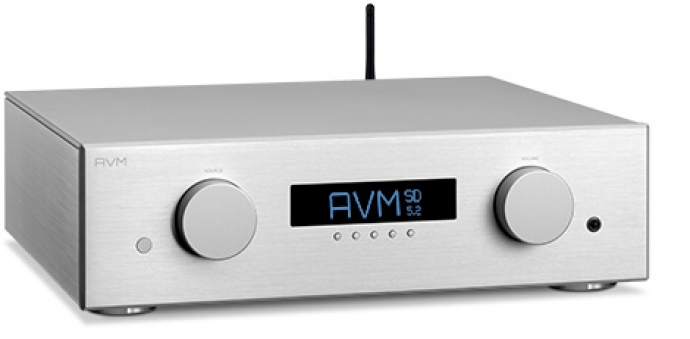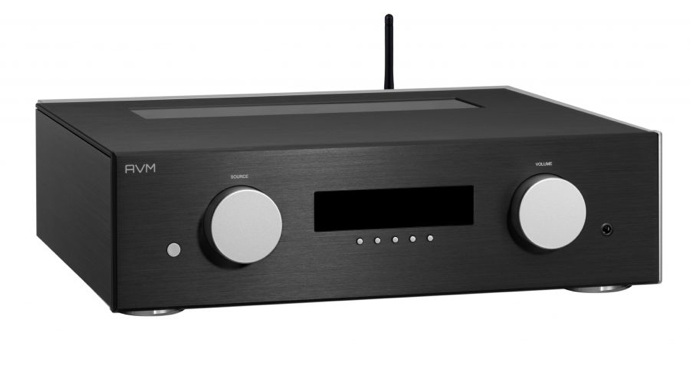
I was excited to see an old friend, Peder Bäckman, again at the Rocky Mountain Audio Fest. He is now the American Sales Manager for AVM of Germany, and AVM had a lot of equipment on display at the show. I was equally excited to receive AVM’s Evolution SD5.2 Streaming DAC/Preamp to review.
AVM’s Evolution products are the company’s “Performance Line” that falls above the Inspiration Line but below the cost-no-object Ovation Line. The Evolution Line consist of two CD players, two DACs, two receivers, three integrated amps, two preamps, one stereo power amp, and a set of mono power amplifiers.
What is the SD5.2?

The DAC/Preamp that is here for review is the Evolution SD 5.2, a streaming DAC with a built-in tube line stage. You can get this DAC in either silver or black. It combines a DAC with DSD, Streaming Client, web radio, analog PreAmp with two analog line inputs and a high-performance headphone amp all in one chassis. It uses two DACs per channel this way, even in the digital domain the music signals are being processed in balanced mode. The streaming engine allows countless formats to be processed, and it is upgradeable making it, as manufacturers love to say “future proof,” at least for additional formats.
The amplifier stages in the preamp are directly derived from the PA 8 of the Ovation Line. The SD 5.2 tube stages use their proprietary selected AVM 83T version of the ECC83 double-triodes tubes, with its own high-voltage generator supply. The RC 9 remote control with color display is available as an option. This programmable and rechargeable remote control always comes with a charging dock. It also comes with the ability to use your phone or tablet as a remote.
On their website, AVM says, “Like all AVM hi-fi components, the SD 5.2 is carefully developed and assembled by our engineers in Malsch, Germany. Our vendors for housing and electronic parts all reside near-by. This proximity helps us to easily ensure and maintain the superb quality level of the supplied parts for the AVM hi-fi component. During the manufacturing process, we repeatedly perform numerous tests to ensure the absolute quality of our products. When the assembling is finished, and the first inspection is done, all units must pass a run in a test to prove their reliability. After that, a careful final inspection follows before packing & shipping. All this ensures creating a perfect product from AVM for our customers.”
Installation and Setup

You might ask why with all the digital audio sources inside the one box the SD 5.2 only has two line level inputs. Chances are the only analog audio sources you still need are for a turntable and maybe an FM tuner or tape deck. The fact that I might want all three makes me wonder why they didn’t give us three analog inputs.
I think the answer is that AVM sees the SD5.2 as a hub for all of your digital devices, and that’s why it comes with a wonderful sounding tube line stage that results in a more analog sounding device. I mean there are seven digital inputs. They have conventional S/PDIF optical and coaxial inputs, through AES/EBU, through to USB (Type A and B), and LAN/WLAN network connections. It can process virtually anything from MP3 up to 32bit/192kHz PCM and 2.8MHz DSD, and it is UPnP and DLNA compatible. It can even stream internet radio sources. It also has on the fly switchable digital filtration for you to use. And, a shock of all shocks nowadays, it even has tone controls! Last but certainly not least, it has a very good Class A headphone amp.
Installation was pretty straightforward, and with some help from my son, I even figured out the streaming. Sonically the SD 5.2 sparks the charming sound of the tube line stages. With almost any source it is capable of giving you a rich, beautiful and emotional musical experience. The SD 5.2 has a sense of sameness across all of the inputs, whether digital or analog. The AVM SD5.2 has a consistently warm but still quick sound. This means that the digital sources never sounded harsh, grating or glaring. It also means as you move from DSD to internet radio there are no abrupt and drastic differences in quality. Yes, you can easily hear the difference in quality, but much like Audio Note’s DACs, you can enjoy both good and not so good recordings and still hear the differences. I’m not saying they sound like Audio Note’s DACs in any other regard.
The Listening Experience
When listening to the SD5.2, I realized that I wasn’t paying much attention to the systems playing of audio effects. I was just enjoying music that I don’t have on vinyl. Yes, It does have an extremely three-dimensional sound stage, and it images in a very natural way. It’s not as detailed as most high-end digital devices, but this never really bothered me. It does have a sense of solidity that many streaming devices I have heard don’t have. Vocals are upfront and articulate, but it never gave me that scary real sound I get from vinyl. Part of what makes it easy to live with its shortcomings is that it has powerful dynamics, good drive and great musical flow as well as exceptional Pace, Rhythm, and Timing. Voices, strings, and horns all sound very natural through the AVM with all the air and nuances that enables them to sound so real.
With the AVM Evolution SD 5.2, my system was very listenable. The truth is, with well-recorded digital music, it was as listenable as any digital device I have had in my system. And it has a way of making poorer recorded music that I love still sound listenable. I was pleased with its ability to let me become emotionally involved in the music. This is an area where most digital sources come up short in my opinion. I just have no interest in listening to music that doesn’t move me. This AVM passes that test with flying colors. I can hear voices, strings and horns, and they all have rich and natural tone.
It has a very organic and tactile sound. Many would say it sounds “like vinyl,” but it doesn’t sound like vinyl. What it does sound a lot like is real music, more than I am used to from most digital players at any price. Let me share with you how a couple of CDs I love sounded using the OPPO 105D as a transport and the AVM SD 5.2 as the DAC.
Let’s start with the Mobile Fidelity Gold Disc Jazz Sampler. There is a reason that on eBay these bring up to $300. Not only are they rare, but the music is great. The first track, with Zoot Sims Quartet playing “Do Nothing ‘Till You Hear From Me” sounded rich and full of life. Zoot’s tenor sax had great tonality, and the bass was full and occupied a real space. The sound stage was huge, which is an area where the AVM is much better than the little 47 Labs player.
Another one of my favorite recordings not available on vinyl is Mary Lou Lord’s Live City Sounds. She recorded the performance with a portable DAT recorder in the subway. I love her covers of Bruce Springsteen’s “Thunder Road,” Bob Dylan’s “You’re Going to Make Me Lonesome When You Go” and my favorite, her cover of Richard Thompson’s “1952 Vincent Black Lightning.” There is purity to this recording that, if played on a good system, is beguiling. I have taken this CD to audio shows, and people always want to know who it is and where can they get the CD. I answer, “Google it.” I don’t remember ever hearing her guitar sound better. Her voice sounded like I was down in the subway listening to her. It was a privilege to hear this on the AVM in my big rig; it sounded so much more involving than it has before on other digital devices. CDs like these two are the reason I’m reconsidering a way of play CDs in my main system downstairs. I so enjoyed listening to this CD that isn’t available on LP from a source that sounds this good.
Conclusion
The AVM Evolution SD 5.2 is the perfect example of a source that sounds more like music than audio effects. It can replace several devices in one simple box. It’s simple to use, sounds good and becomes the hub of your system. Highly recommended for a digital system.
Technical Specifications
Price $5995.00
Preamp Input sensitivity: 20 mV to 350 mV (adjustable) Input impedance (line): 10 kOhm
Frequency response: < 5 Hz – > 80 kHz, 30 Hz – > 20 kHz TIM: 0.01% (mostly K2)
Sampling frequency: upsampling switchable up to 192 kHz / 24 Bit
DAC frequency range: <20 Hz – 20 / 80 kHz (depending on input sampling frequency)
De-emphasis: yes, automatic
Input format: Dig in opt/coax S/PDIF: 33 kHz – 96 / 192 kHz
DSD (via USB): 16–24 Bit 64DSD (2,8 MHz)
Synchronous USB input: 48 kHz /16 Bit (no driver needed), 192 kHz / 24 Bit (driver needed for PC)
TIM (related to digital 0): 110 dB(A)
Streaming Formats Supported: MP3 , WMA, AAC, OGG Vorbis, FLAC (192 / 32 via LAN), WAV (192 / 32 via LAN), AIFF (192 / 32 via LAN), ALAC (96 / 24 via LAN) UPnP 1.1, UPnP-AV and DLNA compatible server, Microsoft Windows Media Connect Server (WMDRM 10)
DLNA compatible server: NA
Radio Database: vTuner (automatic updates)
